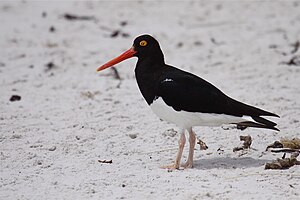Tierra del Fuego oystercatcher
| Tierra del Fuego oystercatcher | ||||||||
|---|---|---|---|---|---|---|---|---|

Tierra del Fuego oystercatcher ( Haematopus leucopodus ) |
||||||||
| Systematics | ||||||||
|
||||||||
| Scientific name | ||||||||
| Haematopus leucopodus | ||||||||
| Garnot , 1826 |
The Tierra del Fuego oystercatcher ( Haematopus leucopodus ) is a species of bird from the monogeneric family of oystercatchers . It occurs exclusively in South America.
Appearance
The Tierra del Fuego oystercatcher reaches a body length of 42 to 46 centimeters. The wing length is 23.7 to 26.7 centimeters. The weight varies between 585 and 700 grams. There is no noticeable sexual dimorphism , but the females tend to be a bit heavier and have a slightly longer beak. This is a little more dull red in color than the males.
The Tierra del Fuego oystercatcher, like many other species of the oystercatcher genus, has striking black and white plumage and a long red beak. Adult birds have a glossy black head, an equally colored chest and upper body. The belly and the under wing coverts are pure white. The long beak is bright orange-red, the legs and feet are pale pink. The eyes and the dark circles are bright lemon yellow. Fledglings are similar to adult birds but have a more brownish bill and their feet and legs are pinkish-gray.
Distribution area
The range of the Tierra del Fuego oyster fishermen are the beaches from the center of Chile and the south of Argentina to Tierra del Fuego and the islands of the Cape Horn region. They are also found in the Falkland Islands , where the population is around 7,000 to 13,000 breeding pairs.
Way of life
The Tierra del Fuego oystercatcher eats worms as well as mussels and small snails. The way they feed is no different from that of other oystercatcher species: In order to capture mussels, oystercatchers prefer to look for specimens with a cracked shell. Here the beak drives through the gap inside, so that the sphincter can be destroyed and the shell opens. Often the mussel shells are also destroyed from the outside with beak blows.
In the winter months, the Tierra del Fuego oystercatcher occasionally forms schools of up to 100 individuals. The breeding biology of the Tierra del Fuego oystercatcher has not yet been very well studied. On the Falkland Islands reproduction time falls within the period of September and October, which is about one month earlier than in sympatric occurring South American oystercatchers . The nest is a shallow hollow in the sand or alluvial seaweed. The clutch consists of two dark olive-brown or greenish eggs. Nothing is known about the breeding period and the period until the young birds fledged.
supporting documents
literature
- Hadoram Shirihai: A Complete Guide to Antarctic Wildlife - The Birds and Marine Mammals of the Antarctic Continent and Southern Ocean . Alula Press, Degerby 2002 ISBN 951-98947-0-5
- Robin and Anne Woods: Atlas of Breeding Birds of the Falkland Islands . Anthony Nelson, Shropshire 1997 ISBN 0-904614-60-3
Single receipts
- ↑ Hadoram Shirihai: A Complete Guide to Antarctic Wildlife - The Birds and Marine Mammals of the Antarctic Continent and Southern Ocean . Alula Press, Degerby 2002, p. 254
- ↑ Hadoram Shirihai: A Complete Guide to Antarctic Wildlife - The Birds and Marine Mammals of the Antarctic Continent and Southern Ocean . Alula Press, Degerby 2002, p. 256
Web links
- Haematopus leucopodus inthe IUCN 2013 Red List of Threatened Species . Listed by: BirdLife International, 2012. Retrieved January 14, 2014.